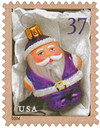
2004 37c Contemporary Christmas: Purple Santa Ornament
# 3883 - 2004 37c Contemporary Christmas: Purple Santa Ornament
$0.35 - $3.20
U.S. #3883
Santa Ornaments
Contemporary Christmas
Santa Ornaments
Contemporary Christmas
Issue Date: November 16, 2004
City: New York, NY
Quantity Issued: 125,000,000
City: New York, NY
Quantity Issued: 125,000,000
Decorated Christmas trees are a German tradition. Originally, the decorations were gifts and treats like fruits, nuts, berries, and cookies.
Delicate blown-glass Christmas tree ornaments also began in Germany. Early in the 1800s, glass blowers in Lauscha, in the forested Thuringian Mountains of eastern Germany, made large, silvered glass balls called “kugels” that were hung from ceilings for decoration.
Before long, the glass blowers were making small, shiny kugels for Christmas trees. In the 1860s, artisans began to blow the hot glass into molds shaped like pine cones, fruits, bells, trumpets, stars, angels, and Santas.
During Queen Victoria’s reign, these bright glass ornaments became popular in England and replaced the fresh fruit once used on British Christmas trees. In the 1890s, colorful Lauscha ornaments were popularized in America by F.W. Woolworth in his 5-&-10¢ stores.
By 1930, with about 2,000 families producing 300 to 600 ornaments per week, Lauscha was known as the “Tree Ornament Capital of the World.”
After World War II, many Lauscha glass blowers escaped to West Germany to continue the hand-blown glass tradition. Today, German glass blowers use antique molds to create delicate ornaments in traditional designs.
U.S. #3883
Santa Ornaments
Contemporary Christmas
Santa Ornaments
Contemporary Christmas
Issue Date: November 16, 2004
City: New York, NY
Quantity Issued: 125,000,000
City: New York, NY
Quantity Issued: 125,000,000
Decorated Christmas trees are a German tradition. Originally, the decorations were gifts and treats like fruits, nuts, berries, and cookies.
Delicate blown-glass Christmas tree ornaments also began in Germany. Early in the 1800s, glass blowers in Lauscha, in the forested Thuringian Mountains of eastern Germany, made large, silvered glass balls called “kugels” that were hung from ceilings for decoration.
Before long, the glass blowers were making small, shiny kugels for Christmas trees. In the 1860s, artisans began to blow the hot glass into molds shaped like pine cones, fruits, bells, trumpets, stars, angels, and Santas.
During Queen Victoria’s reign, these bright glass ornaments became popular in England and replaced the fresh fruit once used on British Christmas trees. In the 1890s, colorful Lauscha ornaments were popularized in America by F.W. Woolworth in his 5-&-10¢ stores.
By 1930, with about 2,000 families producing 300 to 600 ornaments per week, Lauscha was known as the “Tree Ornament Capital of the World.”
After World War II, many Lauscha glass blowers escaped to West Germany to continue the hand-blown glass tradition. Today, German glass blowers use antique molds to create delicate ornaments in traditional designs.











